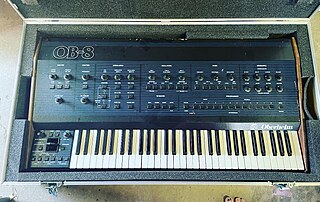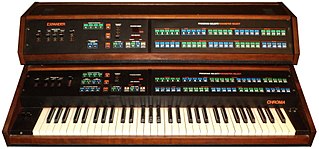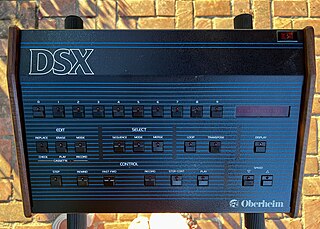
Digital music technology encompasses digital instruments, computers, electronic effects units, software, or digital audio equipment by a performer, composer, sound engineer, DJ, or record producer to produce, perform or record music. The term refers to electronic devices, instruments, computer hardware, and software used in performance, playback, recording, composition, mixing, analysis, and editing of music.
A music sequencer is a device or application software that can record, edit, or play back music, by handling note and performance information in several forms, typically CV/Gate, MIDI, or Open Sound Control, and possibly audio and automation data for digital audio workstations (DAWs) and plug-ins.

An analog synthesizer is a synthesizer that uses analog circuits and analog signals to generate sound electronically.

Oberheim is an American synthesizer manufacturer founded in 1969 by Tom Oberheim.

ARP Instruments, Inc. was a Lexington, Massachusetts manufacturer of electronic musical instruments, founded by Alan Robert Pearlman in 1969. It created a popular and commercially successful range of synthesizers throughout the 1970s before declaring bankruptcy in 1981. The company earned a reputation for producing excellent sounding, innovative instruments and was granted several patents for the technology it developed.
Sequential is an American synthesizer company founded in 1974 as Sequential Circuits by Dave Smith. In 1978, Sequential released the Prophet-5, the first programmable polyphonic synthesizer, which was widely used in the music industry. In the 1980s, Sequential was important in the development of MIDI, a technical standard for synchronizing electronic instruments.

The ARP Odyssey is an analog synthesizer introduced by ARP Instruments in 1972.

The Oberheim Polyphonic Synthesizer is a range of analog music synthesizers that was produced from 1975 to 1979 by Oberheim Electronics. It was developed by Tom Oberheim, and was the first production synthesizer capable of playing chords.

The Oberheim OB-X was the first of Oberheim's OB-series polyphonic analog subtractive synthesizers.

David Joseph Smith was an American engineer and founder of the synthesizer company Sequential. Smith created the first polyphonic synthesizer with fully programmable memory, the Prophet-5, which had a major impact on the music industry. He also led the development of MIDI, a standard interface protocol for synchronizing electronic instruments and audio equipment.
Polyphony is a property of musical instruments that means that they can play multiple independent melody lines simultaneously. Instruments featuring polyphony are said to be polyphonic. Instruments that are not capable of polyphony are monophonic or paraphonic.

The Oberheim OB-8 is a subtractive analog synthesizer launched by Oberheim in early 1983 and discontinued in 1985. As the fourth product in the OB-series of polyphonic compact synthesizers, the OB-8 was the successor to the OB-Xa. The number of production was about 3,000 units.

The Oberheim OB-Xa was the second of Oberheim's OB-series polyphonic analog subtractive synthesizers, replacing the OB-X with updated features.

A synthesizer is an electronic musical instrument that generates audio signals. Synthesizers typically create sounds by generating waveforms through methods including subtractive synthesis, additive synthesis and frequency modulation synthesis. These sounds may be altered by components such as filters, which cut or boost frequencies; envelopes, which control articulation, or how notes begin and end; and low-frequency oscillators, which modulate parameters such as pitch, volume, or filter characteristics affecting timbre. Synthesizers are typically played with keyboards or controlled by sequencers, software or other instruments and may be synchronized to other equipment via MIDI.

The ARP Chroma is a polyphonic, multitimbral, microprocessor controlled, subtractive synthesis analog synthesizer developed in 1979-1980 by ARP Instruments, Inc. just before the company's bankruptcy and collapse in 1981.

The Oberheim OB-1 was a monophonic, programmable, analog synthesizer introduced by Oberheim Electronics in 1978. It originally sold for $1,895 and was the first analog synthesizer capable of storing patches. The design was a replacement for the previous generation of Oberheim SEM based instruments and intended to be used for live performance.
The history of home keyboards lies in mechanical musical instrument keyboards, electrified keyboards and 1960s and 1970s synthesizer technologies.

The Oberheim Two-Voice Pro is an analog music synthesizer that was produced from 2015-2018 under the Tom Oberheim brand. It is an updated version of the original Oberheim Two-Voice, which was produced from 1975-1979.

The Oberheim DSX is a pre-MIDI digital polyphonic sequencer. It operates using a proprietary parallel bus and was designed for use with the OB-X, OB-SX, OB-Xa and OB-8. Connection was via a heavy 1:1 cable, which plugged from the host DSX to the target synthesizer using a rear DB-37 connector. The DSX is capable of driving up to 16 voices concurrently. Sequences are stored in internal memory after power-off using static RAM which remains powered up from an internal NiCad battery.






















